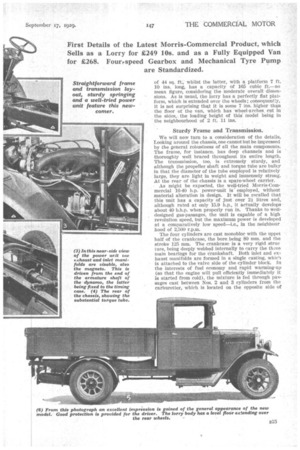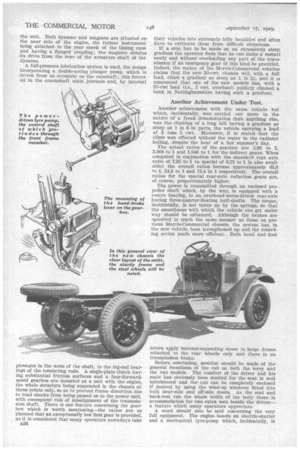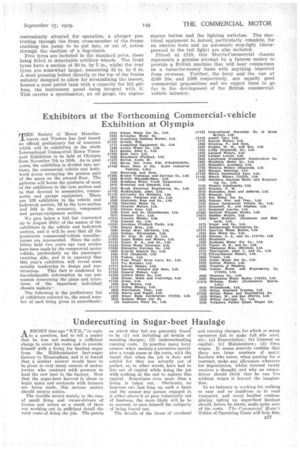A NEW BRITISH LOW-PRICED 30-cwt. CHASSIS
Page 58

Page 59

Page 60

Page 61

If you've noticed an error in this article please click here to report it so we can fix it.
THERE are three main items to be considered when an operator sets himself the task of choosing a new vehicle, or vehicles, to augment his fleet. These are . --The carrying capacity, the general robustness of both chassis and bodywork, and, last, but by no means least, the cost. Each of these items of necessity looms large in the minds of fleet operators, whether large or small.
Morris Commercial Cars, Ltd., of Birmingham, has clearly had all these factors well in mind when laying out its new 30-cwt. van and lorry chassis, for sumdent body body space is provided to meet exacting demands regarding loading capacity and the chassis and all the main components are of really sensible proportions, whilst prices are about the lowest in existence when the exceedingly full equipment which is included in the specification is taken into account.
A Four-speed Gearbox.
Before going into the details of construction, it would seem opportune first to give a general outline of the layout for the main components, at the same time making reference to such items as loading capacity, floor area for the body and the capabilities of the vehicle on the road. The design of the chassis in general follows accepted Morris-Commercial practice; thus we find that the chassis is suspended on semi-elliptic 'springs and is powered by a four-cylindered side-valve engine. An innovation in the new model, however, is that a four-speed gearbox with an 'exceptionally low gear is now included in the specification.
With wheelbase and track dimensions of 10 ft. 8 ins. and 4 ft. 8 ins, respectively, and a compact power-unit, there is ample room for a large-size body to be fitted to the chassis without material overhang behind the rear axle. At the same • time, however, the overall dimensions of the complete vehicle are quite moderate, for the length of the van is less than 16 ft. and the overall width but ft. 11 ins. Another feature which will be appreciated by users who have to . operate in confined spaces is the fact that the steering lock enables the Vehicle to be 'turned in a circle having a diameter only slightly greater than 40 ft.
As we have already indicated, bOth lorry and van bodies are available, the former having a floor area
of 44 sq. ft.,' whilst the latter, with a platform 7 ft. 10 ins, long, has a capacity of 165 cubic ft—no mean figure, considering the moderate overall dimensions. As is usual, the lorry has a perfectly flat platform, which is extended over the wheels; consequently, it is not surprising that it is some 7 ins. higher than the floor of the van, which has wheel-arches. cut in the sides,. the loading height of this model being in the neighbourhood of 2 ft. 11 ins.
Sturdy Frame and Transmission.
We will now turn to a consideration of the details. Looking around the chassis, one cannot but be impressed by the general robustness of all the main components. The frame, for instance, has deep channels and is thoroughly well braced throughout its entire length. The transmission, too, is extremely sturdy, and although the propeller shaft and torque tube' are bulky in that the diameter a the tube employed is relatively large, they are light in weight and immensely strong. Al the rear of the chassis is a spare-wheel carrier.
As might be expected, the well-tried Morris-Commercial 16-40 h.p. power-unit is employed, without material alteration in design. It will be recalled that this rmit has a capacity of just over 2 litres and, although rated at only 15.9 li.p., it actually develops about 40 h.h.p. when properly run in. Thanks to welldesigned gas-passages, the unit is capable of a high revolution speed, but the maximum power is developed at a comparatively low speed—i.e., in the neighbour hood of 2,500 r.p.m.
The four cylinders are cast monobloc with the upper half of the crankcase, the bore being 80 mm. and the stroke 125 mm. The crankcase is a very rigid strue lure, being deeply webbed internally to carry the three main bearings for the Crankshaft. Both inlet and ex7 haust manifolds are formed in a single caking, whicIA is attached to the valve side of the cylinder block. In the interests of fuel economy and rapid warming-up (so that the engine will pull efficiently immediately it is started from cold), the mixture is fed through passages cast between Nos. 2 and 3 cylinders from the carburetter, which is located on the opposite side of the unit. Both dynamo and magneto are situated on the near side of the engine, the former instrument being attached to the rear cneek of the timing case and having a flanged coupling; the magneto obtains its drive from the rear of the armature shaft of the dynamo.
A full-pressure lubrication system is used, the design incorporating a double-acting plunger pump, which is driven from an eccentric on the camshaft; this forces oil to the crankshaft main journals and, by internal passages in the webs of the shaft, to the big-end bearings of the connecting rods. A single-plate clutch having substantial friction surfaces and a four-forwardspeed gearbox are mounted as a unit with the engine, the whole structure being suspended in the chassis at three points only, so as to prevent frame distortion due to road shocks from being passed on to the power unit, with consequent risk of misalignment of the transmission shaft. There is one feature concerning the gearbox which is worth mentioning—the ratios are so planned that an exceptionally low first gear is provided, as it is considered that many operators nowadays take B26 their vehicles into extremely hilly localities and often have to extricate them from difficult situations.
If a stop has to be made on an excessively steep gradient the operator feels that he can make a restart easily and without overloading any part of the transmission if an emergency gear of this kind be provided. indeed, the maker of the Morris-Commercial vehicles claims that the new 30-cwt. chassis will, with a full load, climb a gradient as steep as 1 in 2, and it is announced that one of the new models has, with a 35-cwt load (i.e., 5 cwt. overload) publicly climbed a bank in Nottinghamshire having such a gradient.
Another Achievement Under Test.
Another achievement with the same vehicle hut which, incidentally, was carried out more in the nature of a freak demonstration than anything else, was the climbing of a long hill having a gradient as steep as 1 in 6 in parts, the vehicle carrying a load of 3 tons 5 cwt. Moreover, it is stated that the climb was effected without the water in the radiator boiling, despite the heat of a hot summer's day.
The actual ratios of the gearbox are 5.98 to 1, 3.368 to 1 and 1.846 to 1 for the indirect gears. When computed in conjunction with the standard rear axle ratio of 7.25 to 1 (a special of 6.75 to 1 Is also available) the overall ratios become approximately 43.3 to 1, 24.4 to 1 and 13.4 to 1 respectively. The overall ratios for the special rear-axle reduction gears are, of course, proportionately higher.
The power is transmitted through an enclosed propeller shaft which, by the way, is equipped with a centre bearing, to an overhead-worm-driven rear-axle having three-quarter-floating half-shafts. The torque, incidentally, is not taken up by the springs, so that the smoothness with which the vehicle can get under way should be enhanced. Although the brakes are operated in much the same manner as those on previous Morris-Commercial chassis, the system has, in the new vehicle, been strengthened up and the retarding action made more efficient. Both head and foot levers apply internal-expanding shoes to large drums attached to the rear wheels only and there is no transmission brake.
Before concluding, mention should be made of the general roominess of the cab on both the lorry and the van models. The comfort of the driver and his mate has obviously been studied for the seat is well upholstered and the cab can be completely enclosed if desired by using the wind-up windows fitted into both near-side and off-side doors. As the seat and back-rest run the whole width of the body there is accommodation for two extra men beside the driver.-a feature which many operators appreciate.
A word should also be said concerning the very full equipment. The engine boasts an electric-starter and a mechanical tyre-pump which, incidentally, is conveniently situated for operation, a plunger pro truding through the front cross-member of the frame enabling the pump to be put into, or out of, action through the medium of a dog-clutch.
Five tyres are included hi the standard price, these being fitted to detachable artillery wheels. The front tyres have a section of 30 in. by 5 in., whilst the rear tyres are somewhat larger, measuring 32 in. by 6 in A steel pressing bolted directly, to the top of the frame suitably designed to allow for streamlining the bonnet, houses a steel petrol tank with a capacity for 101 gal ions, the instrument panel being integral with it This carries a speedometer, an oil gauge, the engine
starter button and the lighting switches. The electrical equipment is, indeed, particularly complete, for an electric horn and an automatic stop-light (incorporated in the tail light) are also included.
Priced at £218, this 'Morris-Commercial chassis represents a genuine attempt by a famous maker to provide a British. machine that will bear comparison on a value-for-money basis with anything imported from overseas. Further, the lorry and the van at £249 10s. and £268 respectively, are equally good commercial propositions and we expect them to go far in the development of the British commercialvehicle industry.




















































































































